How to Effortlessly Remove Grease from Kitchen Cabinets (Guide)
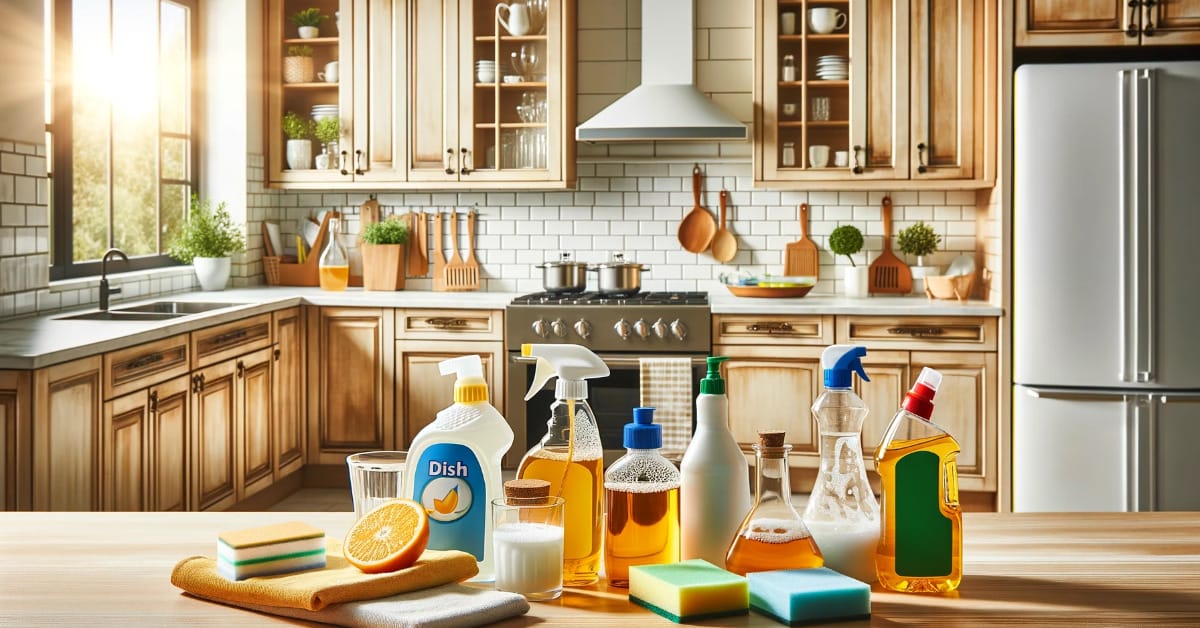
We all know cleaning kitchen cabinets can be daunting, but you can make it a breeze with the right cleaning products and techniques.
Below, I Will Cover 4 Quick and Easy Methods.
🧼Dish Soap and Water
🍋 Citrus-Based Multipurpose Cleaner
🍚 Baking Soda and Water
💪 Commercial Degreasers
Let’s get started!
Tools and Materials
When removing grease from kitchen cabinets, you must have a few tools and materials on hand. Here are some of the essentials:
- Dish soap is a great degreaser and can be used on most kitchen cabinets.
- Baking soda: This natural cleaner removes stubborn stains and grease buildup.
- Vinegar: This acidic substance is great for cutting through grease and grime.
- Microfiber cloths: These soft, lint-free cloths are perfect for wiping down your cabinets without leaving any scratches or streaks.
- Soft-bristled brush: Use this to gently scrub away any stubborn grease or stains on your cabinets.
- Glass cleaner: If you have glass-fronted cabinets, you’ll need a good glass cleaner to remove any streaks or water spots left behind by your cleaning solution.
With these tools and materials, you’ll be well-equipped to tackle even the toughest grease stains on your kitchen cabinets.
Method 1: Dish Soap and Water
When cleaning kitchen cabinets, dish soap, and water are some of the most effective and easiest methods. This method is suitable for most kitchen cabinets and has serious degreasing properties.
Step 1: Mix a few drops of dish soap with warm water in a bowl.

Step 2: Dip a soft cloth or sponge in the solution and wring it out until it’s damp.
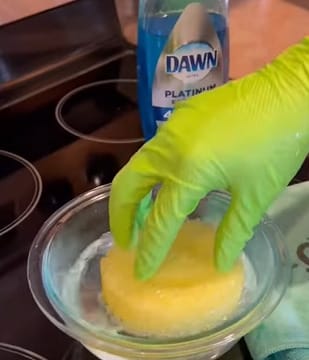
Step 3: Gently wipe down the greasy cabinets and enter the nooks and crannies. For tough stains, let the solution sit on the cabinets for a few minutes before wiping it off.

Step 4: After cleaning, rinse any soapy residue with a clean, damp cloth and dry the cabinets with a clean towel.
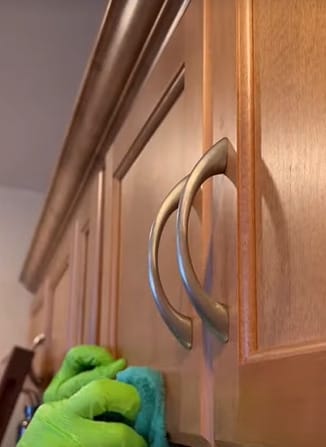
One benefit of dish soap and water is that they are gentle and non-toxic cleaning methods. Plus, it’s affordable and readily available in most households.
However, remember that this method may not be suitable for cabinets with a delicate finish. It’s best to consult a professional or use a specialized cleaning product.
Method 2: Citrus-Based Multipurpose Cleaner
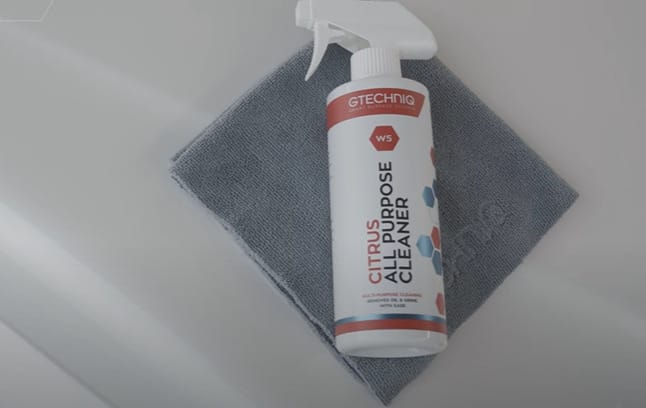
A citrus-based multipurpose cleaner can be an effective solution when removing grease from kitchen cabinets. This type of cleaner contains natural degreasing properties that can help break down grime and grease that stubbornly sticks to your cabinets.
Here are the steps to remove those tough stains on your kitchen cabinet:
Step 1: Spray the cleaner on your kitchen cupboard doors and allow it to sit for a few minutes.
Step 2: Wipe the grease using a damp cloth and a kitchen degreaser.
Step 3: Repeat the process until all the grease is removed.
One of the benefits of using a citrus-based cleaner is that it not only removes grease but also leaves a fresh and pleasant scent. Additionally, this method is environmentally friendly, as it does not contain harsh chemicals that can harm the environment.
Before using any cleaner, it is always advisable to test it on a small, inconspicuous area of your cabinets to ensure that it does not damage the finish.
Method 3: Baking Soda and Water
Another effective method of removing grease from kitchen cabinets is baking soda and water. Baking soda is a natural cleaning agent that can help break down grease and dirt, making it easier to wipe away.
Step 1: Mix a small amount of baking soda with water to create a paste.

Step 2: Apply the paste to the greasy areas of your kitchen cabinets and let it sit for a few minutes.
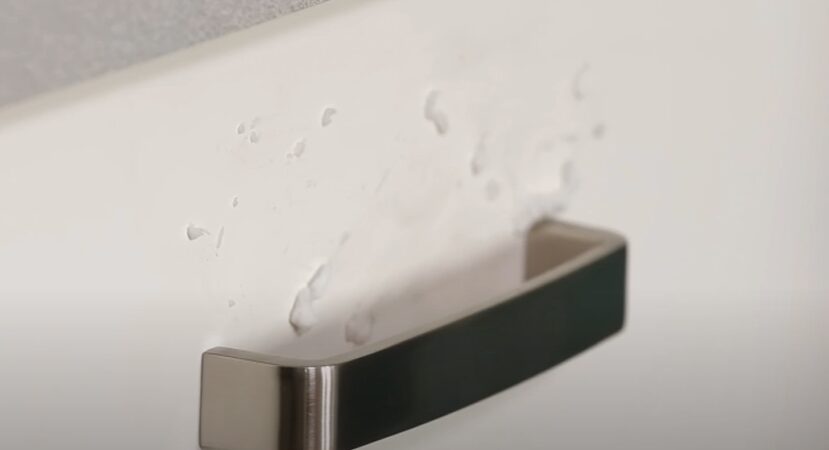
Step 3: Gently scrub the area with a damp cloth or sponge. Rinse with water and dry with a clean cloth.
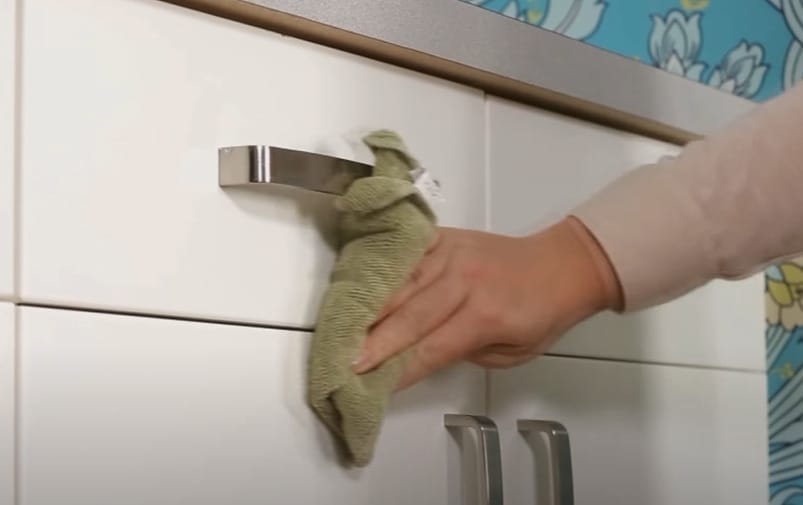
This method is gentle enough for most kitchen cabinets, including wood and laminate. Plus, it’s an affordable and eco-friendly option that doesn’t require any harsh chemicals.
And, as with any cleaning product, be sure to wear gloves and work in a well-ventilated area to avoid any potential health hazards.
Method 4: Commercial Degreasers
When the going gets tough, the tough get commercial degreasers. These heavy hitters are your A-team when home remedies don’t cut it. Before you start, slap on those rubber gloves and pop open a window because safety is the name of the game.
Here’s how you roll:
Step 1: Check the label for the manufacturer’s instructions because each degreaser has its own playbook.
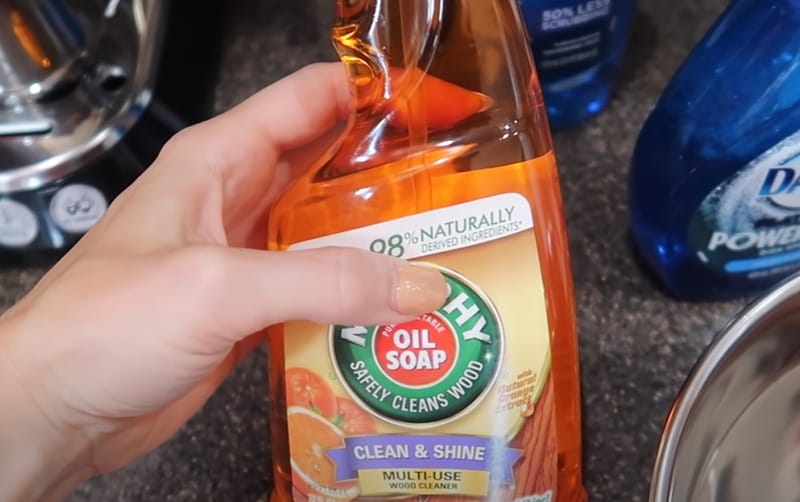
Step 2: Typically, you’ll spray it directly onto the greased-up surface, let it sit, and break down the grease molecules – it’s science doing the heavy lifting.
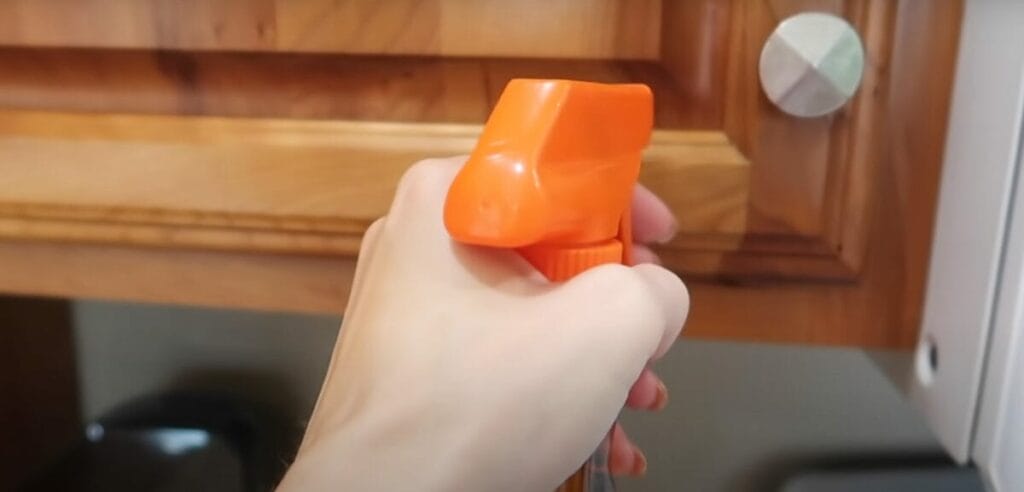
Step 3: After the sitting time, which can be a few minutes, wipe away the grime with a sponge or cloth.

Step 4: Rinse thoroughly with water, stand back, and admire the grease-free glory.
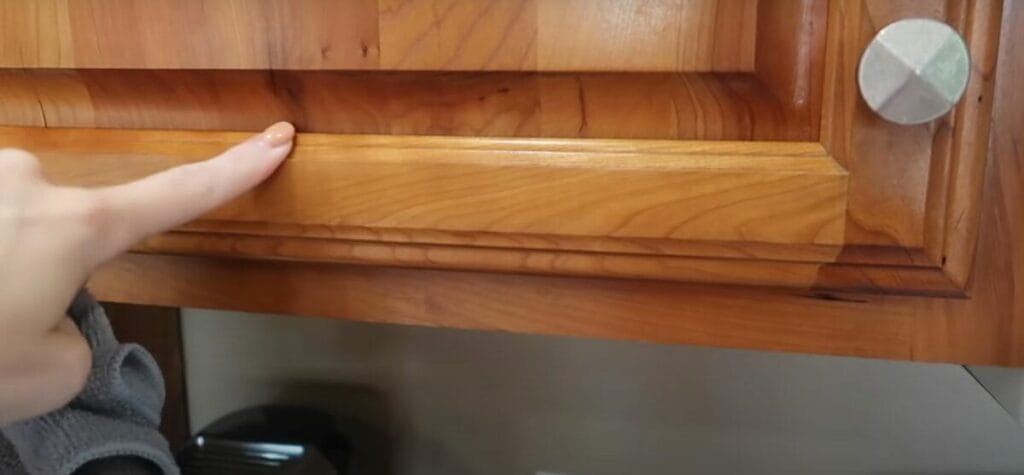
Just like that, you’re the MVP of clean.
Post-Cleaning Care
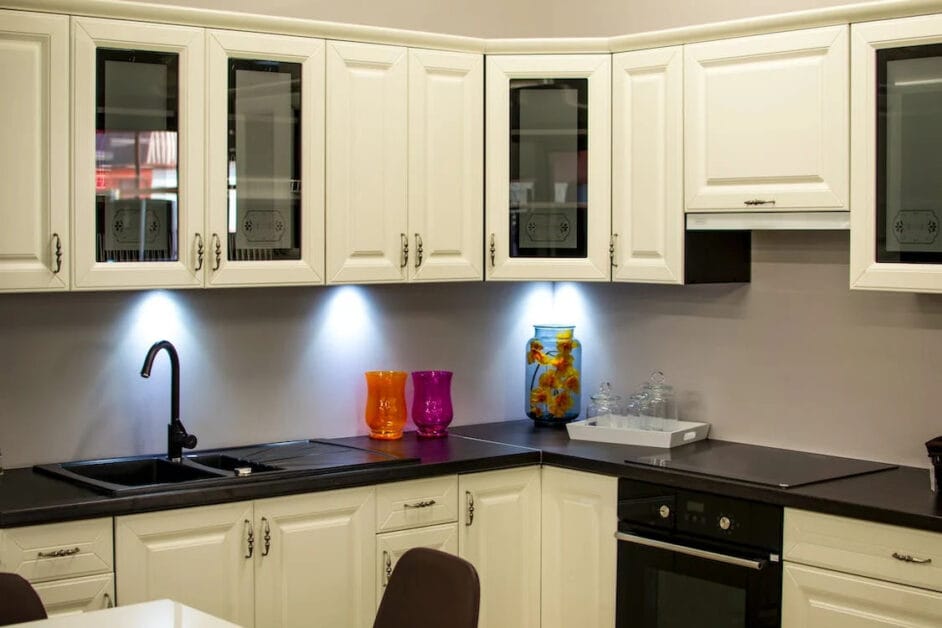
Now that your kitchen cabinets are free of grease and grime, it’s important to take some steps to keep them that way. Here are some tips for post-cleaning care:
- Regular cleaning: To prevent a buildup of grease and grime, it’s important to clean your kitchen cabinets regularly. Depending on how often you cook, you may need to clean them every few weeks or once a month. Use a gentle cleaner like dish soap and warm water to wipe down the cabinet exteriors. Avoid using abrasive cleaners or scrubbers, as they can damage the finish.
- Proper ventilation: Cooking produces a lot of grease and steam, which can settle on your kitchen cabinets and cause buildup. To prevent this, make sure your kitchen is properly ventilated. Use the exhaust fan when cooking, and open a window if possible. This will help to circulate fresh air and prevent moisture buildup.
- Use shelf liners: Consider using shelf liners to protect your cabinets from spills and stains. These can be easily removed and cleaned, and they’ll help keep your cabinets looking new.
- Check for damage: After cleaning your cabinets, take a few minutes to inspect them for any damage. Look for cracks, chips, or other signs of wear and tear. If you notice any damage, take steps to repair it as soon as possible. This will help prevent further damage and keep your cabinets looking great for years.
By following these tips for post-cleaning care, you can help to keep your kitchen cabinets looking clean and fresh. You can enjoy beautiful cabinets free of grease and grime with effort.
Maintenance Tips: Keeping Cabinets Grease-Free
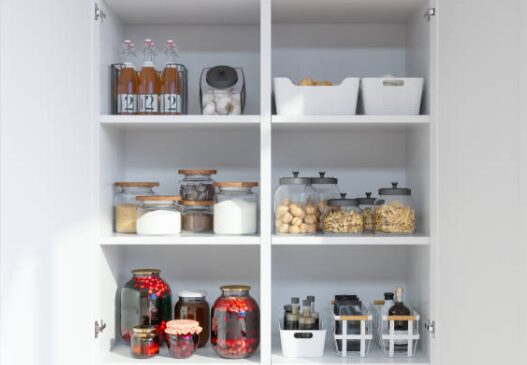
Let’s shift gears to prevention because the best mess is the one you never have to clean.
- Range Hood Use: Activate your range hood fan every time you cook to capture grease before it settles.
- Splatter Screens: Employ splatter screens over pans to shield surrounding areas from oily splashes.
- Microfiber Cloths: Keep microfiber cloths within reach for a quick wipe-down, preventing grease accumulation.
- Weekly Vinegar Wipe: Mix water and vinegar in a spray bottle for a weekly cabinet cleanse that deters grease buildup.
- Semi-Annual Deep Clean: Commit to a yearly detailed cleaning session to maintain a grease-free kitchen environment.
Preventative Measures
As the saying goes, prevention is better than cure. This holds true for kitchen cabinets as well. Here are some preventative measures that you can take to avoid grease buildup on your kitchen cabinets:
- Wipe down your cabinets regularly with a damp cloth to remove any grease or dirt that may have accumulated.
- Use a degreaser spray to clean your cabinets thoroughly. Follow the instructions on the label and wear gloves to protect your hands.
- Avoid using harsh chemicals or abrasive materials that can damage the finish of your cabinets.
- Consider using shelf liners to protect the interior of your cabinets from spills and stains.
- Use a range hood or exhaust fan while cooking to prevent grease from settling on your cabinets.
By following these preventative measures, you can keep your kitchen cabinets looking clean and grease-free for longer periods of time. Remember, a little bit of maintenance can go a long way in preserving the beauty and functionality of your cabinets.
Frequently Asked Questions
- Is It Worth Investing in Professional Cleaning?
- For those deep clean needs or if you’re strapped for time, a pro can get your cabinets back to spick-and-span, no sweat.
- What Should I Do If I Notice Damage While Cleaning?
- Pause the cleaning and assess the situation. If it’s minor, you might be able to touch it up. Major damage might call for a pro.
- Can Grease Build-Up Attract Pests?
- Yes, it can be a dinner bell for unwanted guests. Keep things clean, and you’ll keep them at bay.
- How Can I Tell If It’s Time to Replace My Cabinets Due to Grease Damage?
- If cleaning doesn’t restore them and the finish is compromised, it might be time to consider an upgrade.
- Can Old Grease Stains Be Removed, or Are They Permanent?
- Most can be removed with the right products and elbow grease. For very old stains, refinishing might be necessary.
References
Organizations:
- Environmental Working Group (EWG). https://www.ewg.org/guides/cleaners
- CleanLink. https://www.cleanlink.com/
Books:
- “Clean My Space: The Secret to Cleaning Better, Faster, and Loving Your Home Every Day” by Melissa Maker. https://www.barnesandnoble.com/w/clean-my-space-melissa-maker/1125140690
Website Resources:
- The Home Depot. https://www.homedepot.com/
- Lowe’s. https://www.lowes.com/
Video References:
Clean That Up
Gtechniq UK
Andrea Jean Cleaning
Better Homes and Gardens
